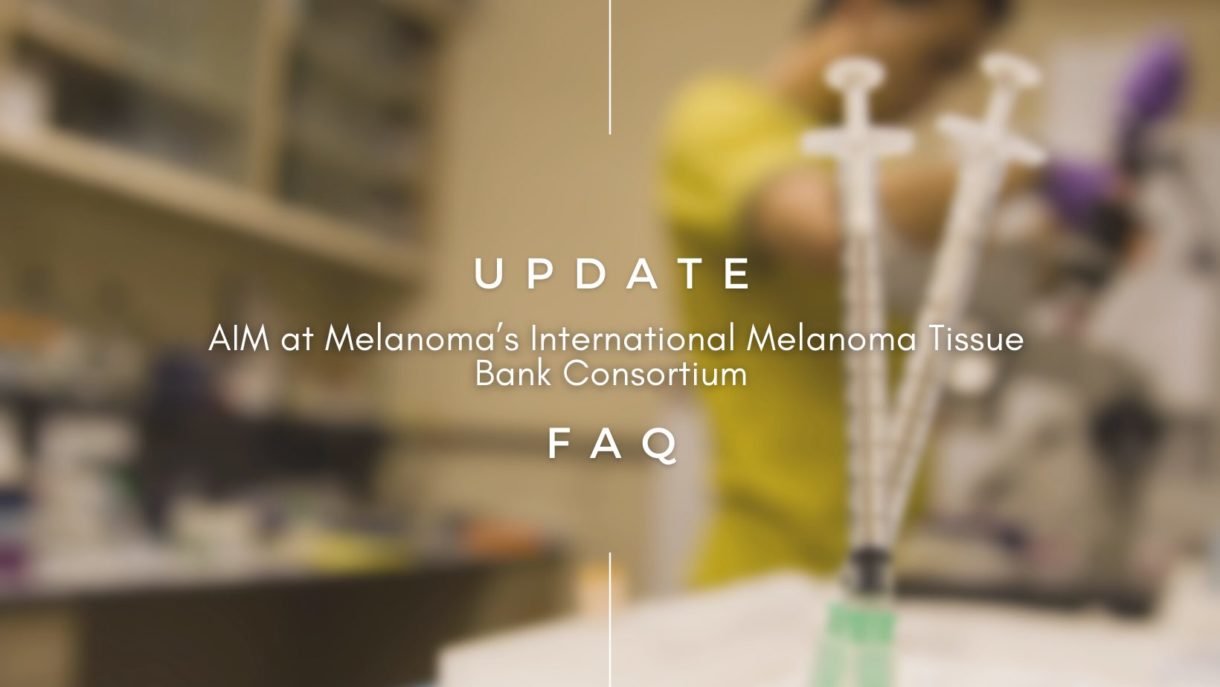FAQ and Update on AIM at Melanoma’s International Melanoma Tissue Bank Consortium

TISSUE IS THE ISSUE
AIM at Melanoma’s major research initiative—the International Melanoma Tissue Bank Consortium (IMTBC)—is the first of its kind in the world. Currently comprising four sites in the U.S. (with two Australian sites to be added soon), the IMTBC is a resource of primary melanoma tumor tissues and data for use by the participating institutions’ researchers as well as researchers around the world who can apply to use the tissue/data.
We had signed contracts to open all four U.S. sites just before COVID hit, and not surprisingly the pandemic dramatically slowed study initiation and tissue collection. We are now resuming or starting normal collection as much as possible as each of the cancer centers/hospitals emerge from the virus and as patients resume normal skin check appointments. We have collected 69 tissues as of the end of the 1st quarter 2022 (March 31).
We get asked certain questions all the time: What is the tissue bank? How does it work? Can I participate? And so on. Here are the answers.
What is the tissue bank—is it an actual building?
The IMTBC is not a building. It operates within existing medical centers. Dermatologists, surgeons, pathologists, and other staff all participate in creating the bank at a participating cancer center.
How does it work?
Here’s how it typically works: A patient goes to see his or her dermatologist for a skin check at one of the tissue bank locations. The physician finds a lesion suspicious for melanoma and intends to biopsy it. Before the excision begins, the physician asks for consent from the patient to use some of the tissue and the patient’s medical information—depersonalized—for research. If granted, a portion of the tissue is removed for the biopsy, and a portion is frozen immediately, which, critically, preserves RNA. The doctor also asks the patient to fill out a special questionnaire and collects other samples such as blood. Staff enter the patient’s medical record and questionnaire answers (again, all depersonalized) into a special database, and the samples and tissue are coded and stored in refrigerators/freezers.
The bank, then, is made up of both fresh-frozen tumor tissue and other samples such as blood, as well as data about each patient.
What will the researchers do with the tissue and accompanying patient information?
After a number of tissues and data are collected from a variety of patients, the researchers can look at these fresh frozen primary melanomas and all of the accompanying patient information and find medical signs or indications, called biomarkers. For example, a researcher can look at all the primaries that ended up metastasizing vs. those that did not spread. Are the tissues that metastasized genetically different? Do they have different biomarkers? And if so, can we devise a test to know whose melanomas will be deadly, and whose will not? Another example: A researcher can look at all the primaries that ended up metastasizing and for which treatment was unsuccessful—the patient died—and compare those primaries to the primaries of patients who responded to treatment. How are those melanomas different? Do they have different biomarkers? Can we figure out in advance who will respond to certain treatments and who will not? And so on.
Can I participate?
At this time, only certain people can participate, and they likely won’t be anyone who is reading this article. Why? Remember that we are collecting primary melanoma tumor tissue—primary means the original melanoma found on your body, the one that was deemed Stage I or Stage II. Those who are reading an article like this are probably long past that original biopsy—though they may be able to participate if they have a second primary melanoma. Further, the patient needs to be seen at one of our tissue bank sites at Hillman Cancer Center, University of Pittsburgh Medical Center (Pittsburgh, PA); Knight Cancer Institute, Oregon Health and Science University (Portland, OR); California Pacific Medical Center (San Francisco, CA); or Robert H. Lurie Comprehensive Cancer Center, Northwestern University (Chicago, IL). Finally, the suspected melanoma must be large enough to bank.
So ironically, it is people likely unfamiliar with the melanoma world and melanoma research—because, at the time of the biopsy, they won’t even know if they have melanoma—whose information and samples will populate this bank and help researchers understand melanoma better.
We hope in the future to have more U.S. sites so we can collect more primary tissue, but for now, we are limited to collecting at the above four U.S. locations.
Why is IMTBC unique?
IMTBC is a global first because of the following combination of factors:
- It’s a consortium—the investigators at the institutions are sharing data and tissue samples with each other
- It’s collaborative—tissue samples and data will be available for researchers around the world to apply to study
- The tissue is fresh frozen—RNA is preserved, unlike in the standard formalin-fixed, paraffin-embedded process
- The tumors are primary—not metastasized
- There will be a critical mass—a goal of 500 to start, and continued collection thereafter
- Full annotation will accompany each tissue—patient data, including full medical history (depersonalized) will be available for study along with the tissue
- Samples accompany each tissue—blood and other samples will be collected for each patient
Why is fresh frozen tissue important?
Formalin-fixed, paraffin imbedded is the standard way of storing primary tumors. In this method, a lot of water is depleted from the tissue, which degrades the proteins. The messenger RNA is also degraded into smaller pieces during the fixing process and researchers want the messenger RNA intact. Fresh frozen tissue preserves RNA. A tumor cell has already initiated an immune response, and researchers are able to recognize that in a fresh frozen piece but not in a formalin-fixed piece.
Why is primary tumor tissue important?
The information in the primary tumor is important because it is fixed. The heterogeneity of the disease can only be read in the primary tumor—it’s the best place to understand the heterogeneity of the disease. There is a tremendous amount of information in the primary tumor that can help us predict the future for the patient if we can learn to read it. The primary tumor has ALL the information about the disease.
The highest degree of genetic alterations is found in the primary tumor. During the course of disease, the tumor loses large DNA fragments. For research, you want to look at the tumor at several “time points,” if possible, starting most importantly with the primary tumor.
If we are going to find predictive or prognostic markers, it will be in the primary tumor.
By contrast, metastasized tumors are a product of the organ in which they are growing, and they will reflect that organ. Some tumor cells go to the lymph nodes, and other cells go into the blood stream, so you don’t get a full picture of the person’s disease from the metastases.
If primary melanoma tissue that is fresh frozen is so important for research, why isn’t there more available?
One reason is that fresh frozen primary melanoma tissue cannot be collected and frozen in a typical dermatologist’s office, and a typical dermatologist’s office is where most melanoma biopsies take place. Most dermatology offices do not have an in-house pathologist, and therefore the dermatologist must physically send their biopsies to an outside pathology office. That situation eliminates the ability to safely separate a portion of the sample and flash freeze it for research without compromising the diagnosis, particularly if the melanoma is small. Even when a dermatologist’s office has an in-house pathologist, most dermatology/pathology offices do not have the time, set-up, or all of the materials needed to quickly freeze the tissue (using liquid nitrogen) or store it (liquid nitrogen freezers operate at –140°C to –196°C). Part of the samples also need to be processed immediately, requiring an on-site laboratory, which is not available in a typical dermatology clinic. And none of the above difficulties includes the very complicated procedures and rules around gathering consent of patients for tissue collection and using that tissue for research—again, a typical dermatology office does not work in this realm.
Dermatology offices located at research institutions, however, with on-site pathology offices and appropriate space and equipment, are the places that can successfully separate, freeze, and store fresh frozen primary tissue for research. But even these places need to be organized, managed, and paid to consent patients appropriately; to put the collection processes in place; to label and store tissue; and to oversee the use of the tissue by internal and external researchers. This organization, management, and funding are what IMTBC has successfully accomplished.
What happens next?
All sorts of things, at once!
- We will continue emerging from COVID-related limitations, so that tissue collection can ramp up to expected levels.
- The principal investigators at the four U.S. sites are devising their first collaborative research project now. Critical mass is important—they’ve had to wait to collect enough tissue to start their research.
- The Australian sites will open, creating the international piece of the bank and initiating further collaboration.
- We will continue preliminary discussions to open branches at other U.S. sites
We will keep you posted on continued progress.
Questions about this article should be directed to Alicia Rowell, Vice President, AIM at Melanoma.
Recent Posts

A Conversation with Dr. Rena Szabo, PsyD on Empowering Patients

Empowering Women in Melanoma: A Look Inside the Women in Melanoma Initiative

Melanoma News and Highlights You Don’t Want to Miss

Coping with Cancer: DBT Skills for Emotional Resilience


